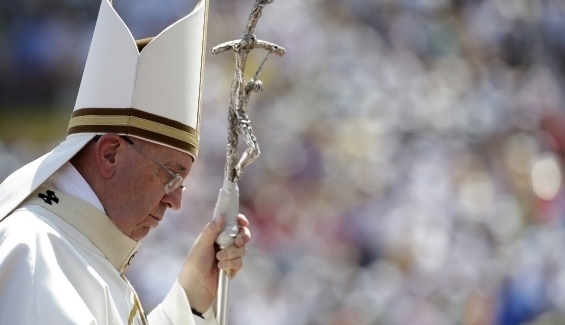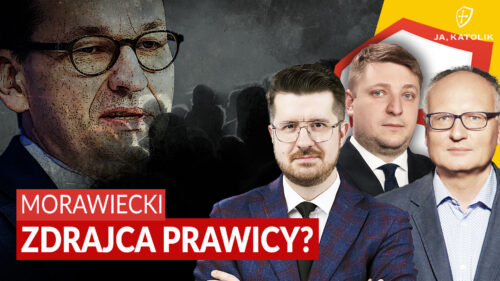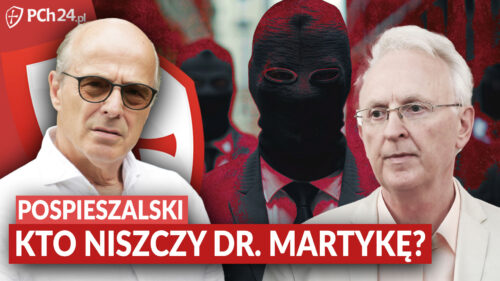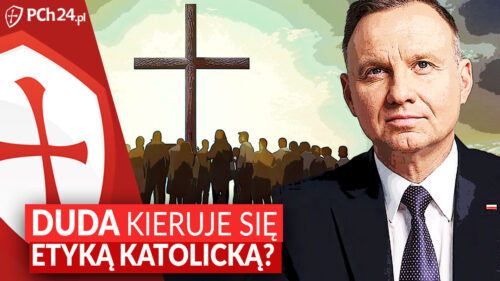Some call Francis a pope-celebrity, others – an alone revolutionary. Some absorb his words and look forward to his non-standard behaviour, others feel anxiety and dismay every time he stands in front of cameras.
The news of Benedict XVI’s intention to abdicate was like a bolt from the blue for the faithful and many of us certainly associate it with the image of a lightning striking the dome of St. Peter’s Basilica on the day of the papal decision. The reasons for his resignation are actually still unknown. In any case, officially given as the main reason the pope’s wish for the Church to be led in the coming hard times with a strong hand by someone healthier and much younger than him wasn’t fulfilled by the cardinals voting at the conclave. A seventy-seven-year-old man became Benedict XVI’s successor, and he already in the second year of his pontificate suggested that he may soon become a retired pope, too.
Wesprzyj nas już teraz!
From the moment of announcing “to the city and to the world” the election of the Argentine cardinal to the papacy, he found himself in the media spotlight and so has it remained for the first two years of his pontificate, during which he has become one of the most quoted celebrities, as well as perhaps the first in many years pope, who could count on overwhelming favour with the media, apparently convinced that there came a man who would rebuild the Church as dictated by the liberals and progressives.
Ostentatious humility and miserabilism
Indeed, already the first gestures of the new pope made just after the conclave provided a clear signal that hard times are coming for the traditionalists. After appearing on the balcony of St. Peter’s Basilica, Francis broke with the traditional way of greeting the faithful for a laconic “good evening” spoken to a crowd cheering in his honour, which was accepted with enthusiasm by the liberal media as a sign of a secular style of the new head of the Church. It has been followed by the dismissal of Vatican dignitaries known for promoting the liturgical traditionalism, the introduction of the Commission into the rapidly growing congregation of Franciscans of the Immaculate, whose friars would celebrate a Mass in the classical Roman rite, as well as the Pope’s statements treating the supporters of a so-called pre-conciliar liturgy as eccentrics yielding to an incomprehensible fad. And all of that within a few months after the abdication of Benedict XVI, who was so supportive to the tradition movement!
But not only the traditionalists in the strict sense could feel confused. Forcing the image of the highest priest as an ascetic, living modestly or even poorly (which is reflected in the resignation from the external signs of the papal majesty, moving to St. Martha’s House instead of living in the apartments occupied by his predecessors, replacing the popemobile with a common Ford, and eating meals in the Vatican canteen), though praised to the skies by the media, started to seem exaggerated and even a bit artificial, according to many priests and an increasing number of the faithful. It’s something like the whims of enlightened French aristocrats who decided to live in the idyllic cottages. Some people began to criticise Francis’s ostentatious humility as being blatant not less than openly demonstrated haughtiness of some princes of the Church. Others pointed to the threat of miserabilism, a false doctrine, according to which poverty in each case is morally purer than wealth, manifesting itself also in the outer escape from wealth to trash and mediocrity, from the beauty of old forms towards modern rubbish. One example of this trend are Francis’s plans to implement a profound reform and even to dissolve the famous Swiss Guard as a formation, being a relic of the former “post-Constantinian” era of the Church, which is too much associated with armed force that used to support the Papal States and, in addition, the Guard is said to be too expensive to maintain.
Strong words addressed to bishops not to have the mentality of Renaissance princes initiated a series of Francis’s “anti-clerical” speeches, which culmination was a Christmas speech to the Roman Curia about spiritual Alzheimer’s disease. Although most of these statements – concerning various abuses and symptoms of the crisis in the Church – appear to be fully justified, their abundance and power have created the impression that the Pope just chose the clerical state as the object of his particularly strong criticism. Needless to say, that happens with extremely loud applause from the liberal media, which very eagerly use the words of the Holy Father to attack the Church and Her priests.
Activists of various Catholic movements have also been told off: a call to Catholics not to obsessively fixate on the point of life defence was like a blow to them. The straw that broke the camel’s back was a recent obvious (let’s face it) bloomer with rabbits, which were supposed to symbolise unwanted reproductive activity of Catholics. Although later denied, it outraged many family-oriented believers who found it unthinkable that they would ever be forced to criticise the Holy Father’s speech.
A scratch on the image of the Pope is also his attitude presented during the last year’s first session of the synod, when the hierarchs courageously defending the traditional doctrine on the indissolubility of marriage and the sinfulness of homosexual practices against the attempts of its destruction taken by the extreme progressives under the leadership of German cardinals Kasper and Marx did not receive a clear support that could have been expected of the Vicar of Christ.
Fluid teaching
St. Bernard of Clairvaux in his small work outlined recommendations for each newly elected pope: You should do everything possible for non-believers to be converted, for the converts not to leave the Church, for the ones who left the Church to return to the faith, for the wicked to move towards righteousness, for the wandering to get back on the road of truth, for the ones seducing others to be defeated with irrefutable arguments and, if possible, converted or at least deprived of the possibility of inciting others to revolt. Doesn’t Francis with his words: “Who am I to judge you?” belong to an entirely different world than the author of these words?
Of course, the Holy Father like his predecessors hasn’t given up on preaching the Good News to the world. On the contrary, he does it in a very impressive way, often using surprising expressions and comparisons, which certainly contributes to increased religious reflection among many of the faithful, for instance when he reminds them about the existence of the hell and the devil or the fundamental role of God’s grace on the way to salvation. His speeches on pastoral and social issues, such as the call to forbid the celebration of Halloween, criticism of homosexual indoctrination or of gender ideology, have received wide coverage.
Pope Francis still expresses his words to the faithful in the traditional way, that is through official documents: Epistles and encyclicals. However, he does so less frequently than his predecessors, but what has become a more important – who knows, maybe even the most important – means of his communication with the world are his statements during various meetings, conferences, and media interviews.
Currently, we are dealing with something what I would call “fluid teaching”. The Pope looks into a camera, says something into a microphone and suddenly it turns out that this is the teaching of the Church. This practice was accurately summed up by an American pro-life activist, Christopher Ferrara, in his interview for “Do Rzeczy”.
Follow the pope. But which one?
While this change in a teaching form is explained by almost all commentators as the answer to the needs of the contemporary informative world, in which lengthy documents simply aren’t read, and what matters is a short and apt bon mot, then even the greatest enthusiasts of Francis can’t hide the fact that spontaneity of his statements combines with ostentatious lack of concern for the coherence of his communication (Tomasz Wiścicki, “Więź”). Others are already talking openly about chaos in that communication, containing contradictory theses, signs, and signals. The question arises whether this form of communication helps to strengthen the brothers in the faith? The lack of coherence is believed to be caused by the Pope’s personality and his desire to be loved by everyone (Lucrecia Rego de Planas, ex-editor in chief of “Catholic.net”), or by intellectual formation of Jorge Maria Bergoglio, who in his youth was under the strong influence of Peronism (John Rao, a journalist of “The Remnant”).
One thing is certain: both Vaticanists and experts in the papacy, as well as common orthodox believers find it difficult to move in the thick of Francis’s statements. A natural desire of the latter group is to follow the voice of the Holy Father, however, when they carefully listen to his voice, they face a serious problem. A Catholic writer, Vittorio Messori, aptly remarked on it in his famous article published in “Corriere della Sera”:
Follow the pope. Yes, but which one? The one at the morning homilies from St. Martha’s House, from the old parish priest sermons full of good advice, wise words, and constant warnings not to fall into the traps laid for us by the devil? Or the one who speaks to Giacinto Marco Pannella, congratulating him on his “good job”, when for decades the “job” of the Radical Party leader consisted in teaching that true charity is a fight for divorce, abortion, euthanasia, homosexuality for everyone, the theory of gender and the like? The pope who in a recent speech to the Roman Curia refers to Pius XII (actually to very St. Paul), defining the Church as a “mystical body of Christ”? Or maybe the one who in the first interview with Eugenio Scalfari mocks those who believe that “God is Catholic”?
The leader of the “people of God”
Despite the impression that sometimes we hear two (or three or even four) completely different Francises, some of the statements – they just happen to be the ones retrieved and particularly publicised by the media – make up quite a logical programme.
Compared to a political doctrine, it could be called a kind of ecclesial Peronism, which is full of paradoxes, by the way. When the Pope met with the representatives of social movements from South America, he presented himself as a Peronist, particularly interested in social problems. At the same time, who is appointed to check the accounts of the Institute of Religious Works? The institution of global capitalism, which Ernst & Young is, as noticed by an Italian historian of the Church, Professor Roberto de Mattei in an interview with “Il Giorno”.
To some extent, Pope Francis appears to be a revolutionary leader. On the one hand, he stresses the importance of community and decentralisation of decision making, but on the other hand, he acts in a manner typical of a revolutionary leader, forcing centralisation and seeking to rebuild existing institutions and traditional structures (which is reflected at least in his plans to reform the Roman Curia and individual dicasteries), while basing on his popularity among “the people” and ruling by means of advisory bodies established by him personally.
Francis’s Peronism has been pushing an option for the poor, stemmed directly from the theology of liberation, stretched at almost all people on the margins of society. Using the sharp criticism of the clergy and its abuses (for instance, he enumerated sixteen major sins committed by priests in a Christmas speech addressed to the Roman Curia cardinals), he has diminished the position of the traditional elites of the Church. At the same time – by stripping the papacy of its splendour in order to bring it closer to every human being (not only Christians) and by pressing the collegiality in decision making – he leads de facto to depriving the papacy of its monarchical character.
One of the leading columnists of the Catholic left wing, Jarosław Makowski, notes with enthusiasm that Bergoglio has stripped the papacy of glitz. This change in the style of the Pope, who wants to be an ordinary priest that calls his faithful and visits the poor in the slums, is approved by the believers. That is how the human face of the papacy is born, the delighted publicist announces, adding that since – according to Francis – a bishop can’t have a prince’s psyche, then the papacy can’t copy monarchy.
The question is whether the momentary satisfaction of equality feelings of the faithful is not too high a price for dismantling the institution that not only – exactly thanks to its monarchical aspect – reflects the hierarchical order of the world and the perfection of God, but also – thanks to its uniqueness – is in a purely secular perspective a reference point for billions of people around the globe?
The style promoted by Francis is informality and being at ease, which are determinants of the lifestyle of contemporary young people. These are reflected in directness of behaviour, liquidity of rules in various spheres of personal and material culture, disregard or even contempt for the canons of clothing, as well as the absence of rigid boundaries between the private and public areas. That “internal” informality translates, of course, into relationships with others, including relations of subordination and dependency, gradually transforming in the egalitarian spirit. The informality appeals to young people, because it doesn’t impose on them the strict requirements of self-discipline and hard work on oneself, usually necessary to equal at least partially those standing higher: superiors or the elder. This style undoubtedly reduces the distance and facilitates communication, but – the question arises here again – is it of any educational value?
Yet in 2013, the media announced the Francis Effect. The popularity of the new pope was said to translate into filled churches and increased numbers of priestly vocations throughout the world. Recently, however, it turned out that the number of seminarians around the world dropped in the year of electing a pope from Argentina and it has continued to go down. Cardinal Robert Sarah, Prefect of the Congregation for Divine Worship and the Discipline of the Sacraments, in an interview with “Le Journal du dimanche” stated that the popularity of Francis is superficial: the faithful want to see the Pope, touch him, take a picture with him, but priests in Italy acknowledge that churches are getting empty.
The enthusiasm of the liberal media has also cooled down due to many “conservative” statements of the Holy Father. In this situation, even they note that the number of believers who wish to meet with Papa Bergoglio in audiences and the Angel of the Lord has been decreasing.
Towards a new aeon?
Professor Jacek Bartyzel wrote on PCh24.pl about Francis as a pope of a new aeon of Christianity: the apocalyptic Church of the Final Days. According to this vision, he would be another in a series of Peters of our times who performs demonarchisation of the Church and prepares Her to descend to the catacombs of overt persecution era that is already underway in many places on earth.
The symbolic doves of peace released by Francis in January 2014 died soon after they ascended above St. Peter’s Square, attacked by gulls and crows. Shortly afterwards, a conflict broke out in Ukraine, as well as the Middle East flared anew, where there is a hecatomb of Christians. Islamic radicals obsessed with lust for murder and destruction, seeking to subject the whole world to a totalitarian system of sharia law, don’t hide that they aim at Rome. On the other hand, a noose of political correctness and various “anti-discrimination” laws increasingly tightens in Western countries, which will soon make life in accordance with the dictates of Christian faith impossible there. Is the arrival of mass persecution of Catholics closer than previously thought?
* * *
Just before the election of Jorge Maria Bergoglio to the Holy See, thousands of Catholics signed a letter addressed to a then still unknown with the name pope, asking him to stop the process of secularisation of the Church.
Holy Father, although we remember a promise of the Lord Jesus Christ that the gates of hell shall not prevail against the Holy Catholic Church, we must admit with a heavy heart that throughout history, Peter’s Boat has never experienced such dramatic and widespread storms like in our day, the authors wrote in their letter, presenting the situation of the silent apostasy of millions of faithful within the Church. They sadly recounted that the fundamental truths of faith are called into question even by the highest hierarchs of the Church, and the basic moral principles – mocked and referred to as obsolete. They also reminded about the crisis of clergy and religious congregations of men and women, as well as about the real tsunami of secularisation, which absorbs Western countries.
Unfortunately, two years after the election of the recipient of this letter to the Holy See, there is greater confusion in the Church than it was at that time, and some gestures and words of the present Holy Father don’t help to calm the disorder either. It is just the opposite: the Pope casts on the faithful a dense network of internally contradictory messages and incentives for making a fuss, which are interpreted by everyone in a different way.
However, let’s remember that as long as the Holy Spirit acts in the flock of Christ, true miracles happen there, for example the pontificate of Blessed Pius IX, who was greeted with enthusiastic acclamation by Masons and modernists as a supporter of progress in the Church, but who went down in history as a great pope, leaving behind the anti-modernism Syllabus of Errors, dogmas of the Immaculate Conception of the Blessed Virgin Mary and papal infallibility.
Therefore, it doesn’t have to be a vain hope that the words of the two-year-old appeal whose addressee is known today will be heard. We beg you, falling to our knees in front of you, do not let the wiles of atheistic and Gnostic secularism ensnare you! Fight it with confidence in God’s help and the fate of millions of souls will again be directed to the right path! Say only one word, using your authority as the Successor of St. Peter, and the satanic smoke will be expelled both from the inside of the Holy Church and the world, like Mother of God promised!
By Piotr Doerre













